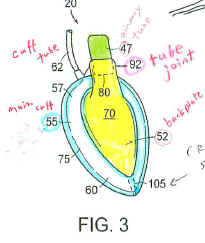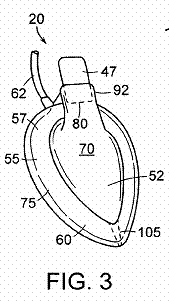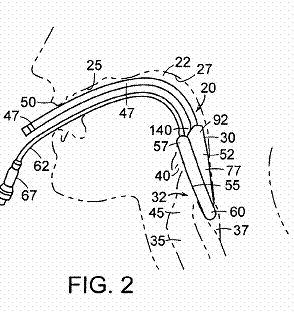

|
(Laryngeal
Mask
Co. (LMA) v.
(Fed Cir) Sep. 24, 2010 本判決は、Ariad判決(2010年3月:CAFC大法廷)以降、112条第1項の「開示要件」を基礎とする無効理由が侵害裁判において頻繁に利用されていることを示す。 また本件特許は100%機械発明(クレームの構成要素に電気・電子・ソフトウエア・化学の関与がない)であり、112条第1項の「開示要件」をメカ関連のクレームでどのように判断するべきかの一つの指針になる判決と考えます。 また、発明の要約部(Summary of the Invention)の記載がクレーム解釈に重要であることを再認識させる事件である。 発明の要約部に従属項に対応する構成とその作用効果を記載するにしても"in a preferred aspect"と記載することで、in a preferred aspectで記載された構成要件がクレーム1の必須構成要件ではないと解釈されることを示す一つの判例でもあると理解されます。 さらに、カリフォルニア南部地区連邦地裁において112条第1項の開示要件の判断基準が根本的に間違っている(112条第1項の開示要件の判断は事実問題であるのに拘らず略式判決を認めた)など、Ariad判決後に連邦地裁において112条、「開示要件」の判断が現段階では難航していることを示す判決でもあると理解されます。 Case Summary by Tatsuo YABE Nov.
25, 2010
|
*************************************************************************
CAFC(連邦巡回区控訴裁判所)はカリフォルニア州南部地区連邦地裁の(1)非侵害、および、(2)クレーム無効の略式判決を破棄・差し戻した。 問題となった特許は2007年1月2日に発行された米国特許第7156100号で、1998年の英国出願から優先権主張したLaryngeal(喉頭部)マスク(麻酔時に使用するマスク)に関する発明を規定しており、クレーム1は以下の通り
Claim 1:
1.
A
laryngeal(喉頭部)-mask
airway device comprising:
a backplate
(52) defining a passage (110);
an inflatable
cuff (55),
the
cuff defining a distal region and a central opening at least when inflated, the
cuff being attached to the backplate,
the
cuff being insertable through a mouth of a patient to an inserted location
within the patient,
an
airway (47) extending from a laryngeal inlet of the patient, through the central
opening, to the passage (110) when the cuff is inflated and at the inserted
location, at least a portion of the posterior(後方)portion
of a wall of the cuff in the distal region being thicker
and stiffer (105) than other portions of the cuff.


で、従来例の問題として、喉に挿入するときにLaryngealマスクの先端部が喉の壁と接触し折れ曲るという不具合を防ぐためにバックプレート52の先端部を厚くし、剛性を上げたことが発明の要(かなめ)である。 特許権者であるLMA社はAmbu社の製品が同特許を侵害しているとし、カリフォルニア州南部地区連邦地裁に提訴した。 同地裁はAmbuの問題となる製品のエアーチューブはバックプレート(Backplate)と一体的に形成されており、バックプレートにチューブ連結部が存在しないとして、Ambuの略式判決の申立てを認め、非侵害とした。 さらに、Ambuはクレーム1は、カフの補強部(thicker & stiff portion)がバックプレートに連結されている形態と、非連結の形態の両方を含むように記載されているが、明細書には非連結の形態をサポートする開示がないとし、112条第1項の「開示要件」を満たさないとし、非侵害の略式判決を申立てた。 SD-Cal地裁は当該略式判決の申立を認め、LMAの特許は無効であると判示した。
LMAはSD-Cal地裁の上記略式判決、(1)非侵害、と(2)無効を不服としCAFCに控訴し、CAFCは当該略式判決を破棄し、地裁に差し戻した。
CAFCでの争点は以下の2つである:
第1争点:
クレーム1のバックプレート(Backplate)はチューブ連結部92を必須要件としてクレーム1を解釈するべきか? 言い換えると、クレーム1のバックプレートはチューブジョイントを必須の構成要素とすると解釈されるならば、エアーチューブとバックプレートが一体的に形成されたAmbuの製品は非侵害と判断される。
第2争点:
クレーム1のカフの先端の補強部(thicker and stiffer portion)はバックプレートに連結する状態と非連結の状態(カフの補強部がバックプレートと分離している状態)を包括するように表現されているが、明細書には当該非連結の状態に相当する開示(サポート)がないということでクレーム1は112条第1項の開示要件を満たさないとして無効と判断されるのか?
CAFCのOPINION:
第1争点に関して:
チーフジャッジ、Rader判事を含む3人のジャッジパネルで審理が行われた。 今回の審理において、CAFC自身も本件は困難な事件であると述べるとともに、本事件は微妙な判断を要すると言及した。 しかし、CAFCはクレーム、明細書、および、図面を参酌するに、チューブ連結部はバックプレートの必須要素ではないと判断した。 同結論に至った理由として、(i) クレーム1の構成要件はバックプレートとカフであり、(ii) 発明の要約のセクションにおいてもバックプレートにチューブ連結部があることが必須要件であるとは記載されていない、また、(iii) 明細書のコラム6(3−5行)にチューブ連結部がバックプレートの一部であっても良いことが記載されている、さらには、(iv) 特許発行前にクレーム1からエアーチューブとチューブ連結部に関連する文言を削除する補正を実施し、審査官はそれを認めて特許したという事実がある。 尚、特許発行前のLMAによるクレームの補正理由はAmbuの製品を分析し、それを包括することを目的としたとAmbuが主張したが、CAFCは同補正理由は成立したUSP100特許の権利範囲の解釈に影響を与えるものではないと言及した。
第2争点に関して:
CAFCは、まず112条第1項の「開示要件」を満たすか否かの判断は事実問題であるとし(ICU Med Inc v Alaris Med Sys CAFC2009)、同条文の要件で特許を無効にするには明白、且つ、説得性のある証拠でもって証明しなければならない(米国特許法第282条の基に成立した特許には有効性が推定される)と基準を述べた。 CAFCは発明の要約(Summary of the Invention)のセクションを参照し、USP100特許にはカフの補強部がバックプレートに連結されていることを要件としていないとし、さらに、好適な実施形態として「カフの補強部がバックプレートから延設している」と記載(コラム1:64−67行)されているので、当業者であればこの箇所から補強部とバックプレートが連結されていることが必須要件ではないと理解するであろうと述べた。
上記理由により、CAFCは下級審(SD-Cal)の略式判決を破棄・差し戻した。
判決文(原文)は:
http://www.cafc.uscourts.gov/images/stories/opinions-orders/10-1028.pdf
------------------------------------------------------------------------------------------------------
(以下英文によるケースサマリー)
Laryngeal
Mask Co. (LMA) v.
Case
Summary by Tatsuo YABE:
BASIC
FACTS:
Patentee:
LMA
Patent
in Question: USP7,156,100 issued
Filing
Date:


Accused
Infringer: AMBU
Accused
device: no tube joint because the mask structure and the airway tube are
integrally molded- they are one continuous piece rather than two pieces joined
together by a joint.
BACKGROUND:
LMA
sued AMBU based on USP’100 for patent infringement.
District Court for S.D. Cal. granted Summary Judgment that (i) AMBU’s
device does not infringe the patent because there is no tube joint in their
device; and (ii) all claims of USP’100 were invalid for fail to satisfy W-D
requirement under 112(1).
CAFC
found the district court erred in its claim construction of the term “backplate”.
CAFC also found that there is a genuine issue of material fact which
precludes SJ on the issue of W-D. Thus,
CAFC vacated the district court's judgment of invalidity and remand back to the
district court for further proceedings.
The
‘100 patent relates to a laryngeal mask airway device which is an artificial
airway device used to deliver anesthetic gases during surgery and to establish
unobstructed airways in patient in emergency situations.
ISSUES:
The
first issue
was whether the claim term “backplate”
must include a tube joint (92) or
not. If the term “backplate” includes a tube joint then there is no infringement.
Claim 1:
1.
A
laryngeal(喉頭部)-mask
airway device comprising:
a backplate (52) defining a passage
(110);
an inflatable cuff (55),
the
cuff defining a distal region and a central opening at least when inflated, the
cuff being attached to the backplate,
the
cuff being insertable through a mouth of a patient to an inserted location
within the patient,
an
airway (47) extending from a laryngeal inlet of the patient, through the central
opening, to the passage (110) when the cuff is inflated and at the inserted
location, at least a portion of the posterior(後方)portion
of a wall of the cuff in the distal region being thicker
and stiffer (105) than other portions of the cuff.
The
second issue
was whether a claimed thicker &
stiffer cuff portion which may include both (i) one being connected to a
backplate and (ii) another one NOT connected to a backplate is invalid for
failure to meet the W-D requirement under 112(1) because of the fact that the
spec only discloses ONLY the (i) one being connected to a backplate.
CAFC’s
OPINION:
Re
First Issue:
-
The district court’s claim construction regarding the
“backplate” of claim 1 is in error.
-
The spec is the single best guide to the meaning of a
disputed term.
-
This is a difficult case of claim construction.
-
Although it is a close case, in light of the claim language,
spec, and prosecution history, CAFC concludes that the term backplate is not so
limited.
-
The claim covers a laryngeal mask airway device which
comprises only a backplate and a cuff.
-
There is only one
place in the spec which indicates that the tube joint is part of the
backplate (figs 5 & 6) col. 6; lines 3 to 5.
-
The Summary of the
Invention does not say that backplate requires to include a tube joint.
-
LMA, just prior to issuance, deleted language concerning the airway tube and the tube joint. (the
Claim 1 previously required that the backplate include a tube joint).
-
AMBU argued that LMA amended its claims in an effort to cover
Ambu’s recently marketed mask which has a unitary structure lacking a tube
joint. It does not matter why LMA
amended its claims.
-
There are 2 prior art patents listing the same inventors,
relating to the laryngeal mask device which uses the term, “backplate” but neither includes a tube joint.
Re
Second Issue:
-
Compliance with the W-D requirement under 112(1) is a question
of fact. ICU Med., Inc. v. Alaris Med. Sys., Inc. (CAFC: 2009)
-
Adequate W-D requires that the applicant “convey with
reasonable clarity to those skilled in the art that, as of the filing date, he or she was in possession of the claimed invention.” Vas-Cath Inc. v. Mahurkar
(CAFC 1991).
-
Issued
patents are presumed valid under 35 USC 282 and Ambu must demonstrate by clear and convincing
evidence that the claims at issue are invalid for lack of W-D. ICU
Medical
-
CAFC concludes that the district court erred in granting SJ
that the patent was invalid for failing the W-D requirement.
-
The Summary of the
Invention does no require that the cuff reinforcement be connected to the
backplate.
-
The Summary of the Invention further states that “in
a preferred aspect,” the reinforcement extends from the backplate. See
col.1, lines 64 to 67 à
CAFC agrees that PHOSIA could read these disclosures as providing for a cuff
reinforcement in the distal region that need not be connected to the backplate.
-
Moreover, CAFC agrees that PHOSIA read the thickened cuff
portion needs not be connected to the backplate.
CONCLUSION:
CAFC
vacates the district court’s order
of non-infringement and its judgment of invalidity for lack of W-D and thus remands
for further proceedings consistent with this opinion.